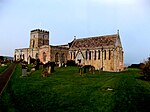Brada Hill
BamburghEscarpments of EnglandHills of NorthumberlandSites of Special Scientific Interest in NorthumberlandSites of Special Scientific Interest notified in 1986
Brada Hill is a small hill escarpment near the coast of north Northumberland in North East England, designated as a Site of Special Scientific Interest (SSSI). The 2.4 hectares (5.9 acres) site is an outcropping of a local stone group, the Whin Sill, on which grows a range of flora representative of the thin, drought-prone soil conditions and influenced by the underlying geology.
Excerpt from the Wikipedia article Brada Hill (License: CC BY-SA 3.0, Authors).Brada Hill
B1342,
Geographical coordinates (GPS) Address Nearby Places Show on map
Geographical coordinates (GPS)
| Latitude | Longitude |
|---|---|
| N 55.599293 ° | E -1.745023 ° |
Address
B1342
NE69 7AJ
England, United Kingdom
Open on Google Maps






